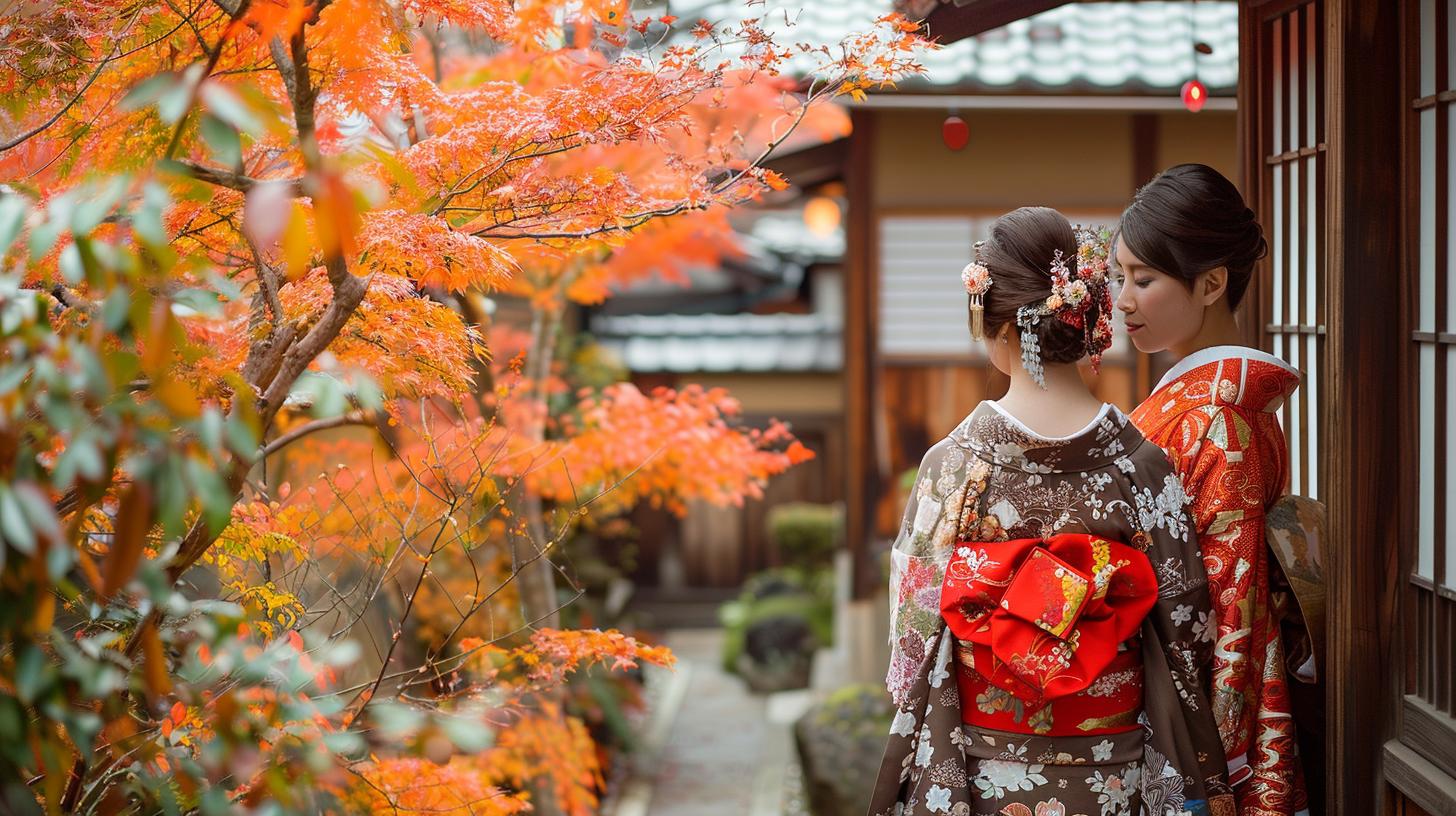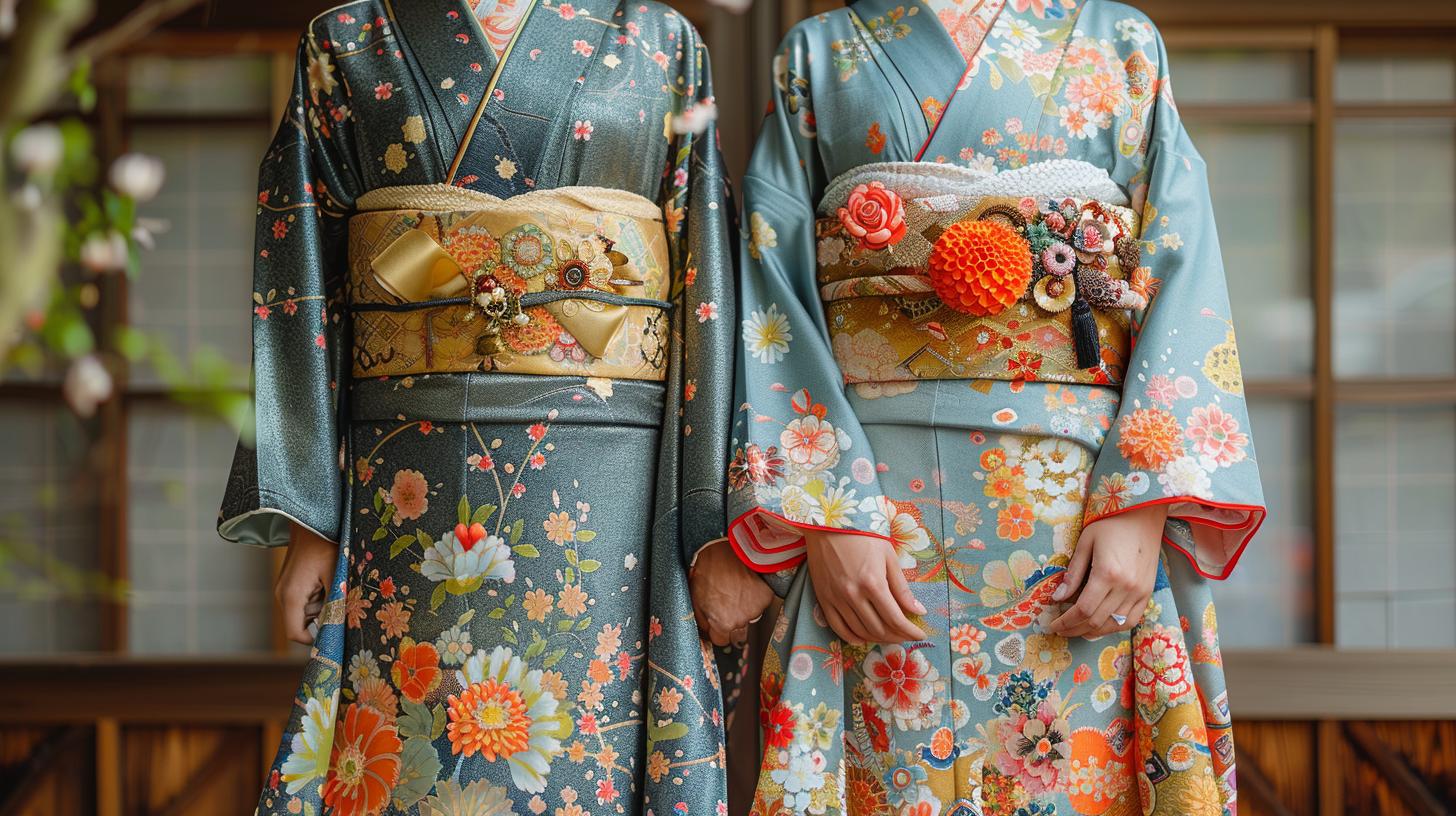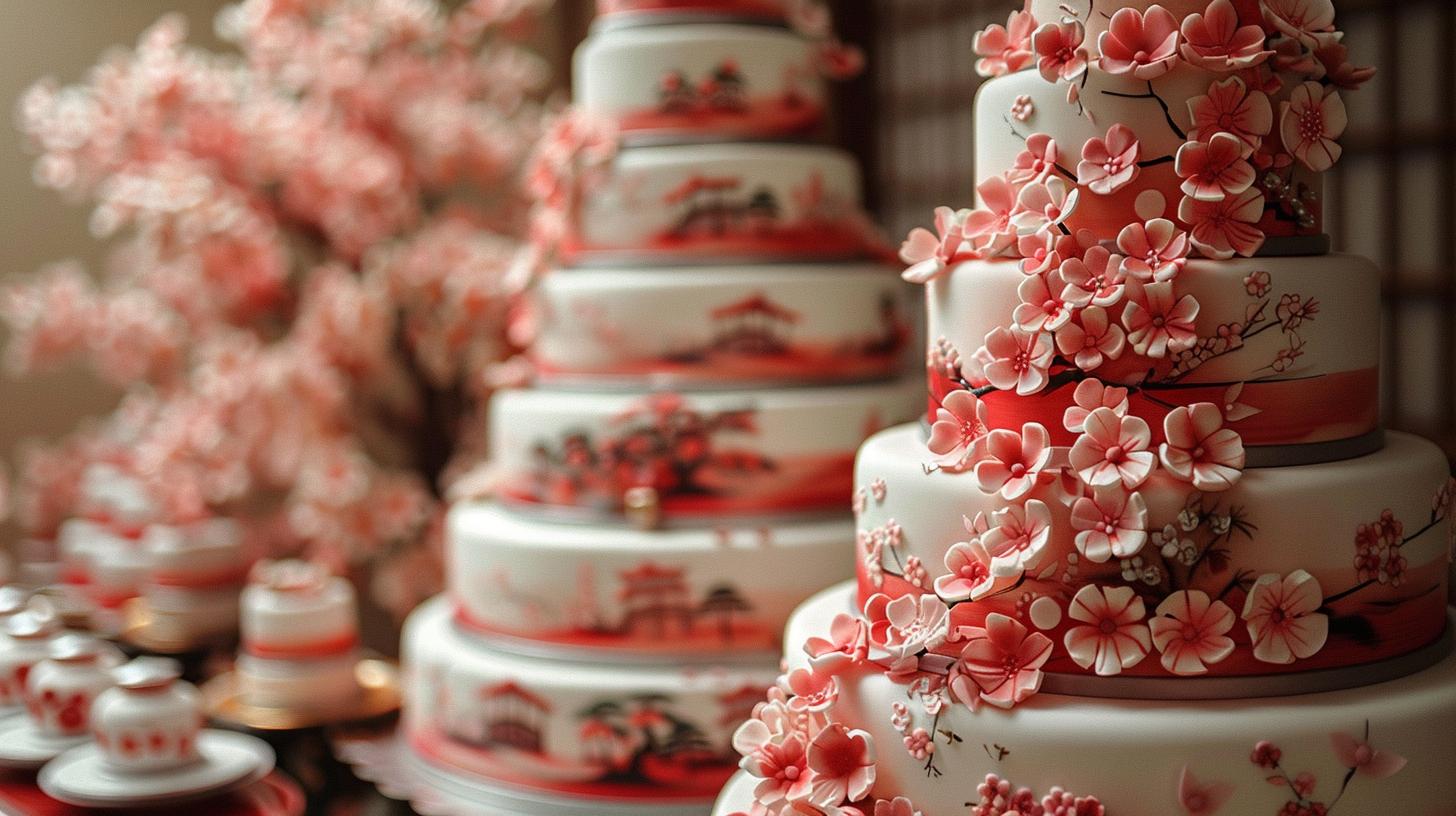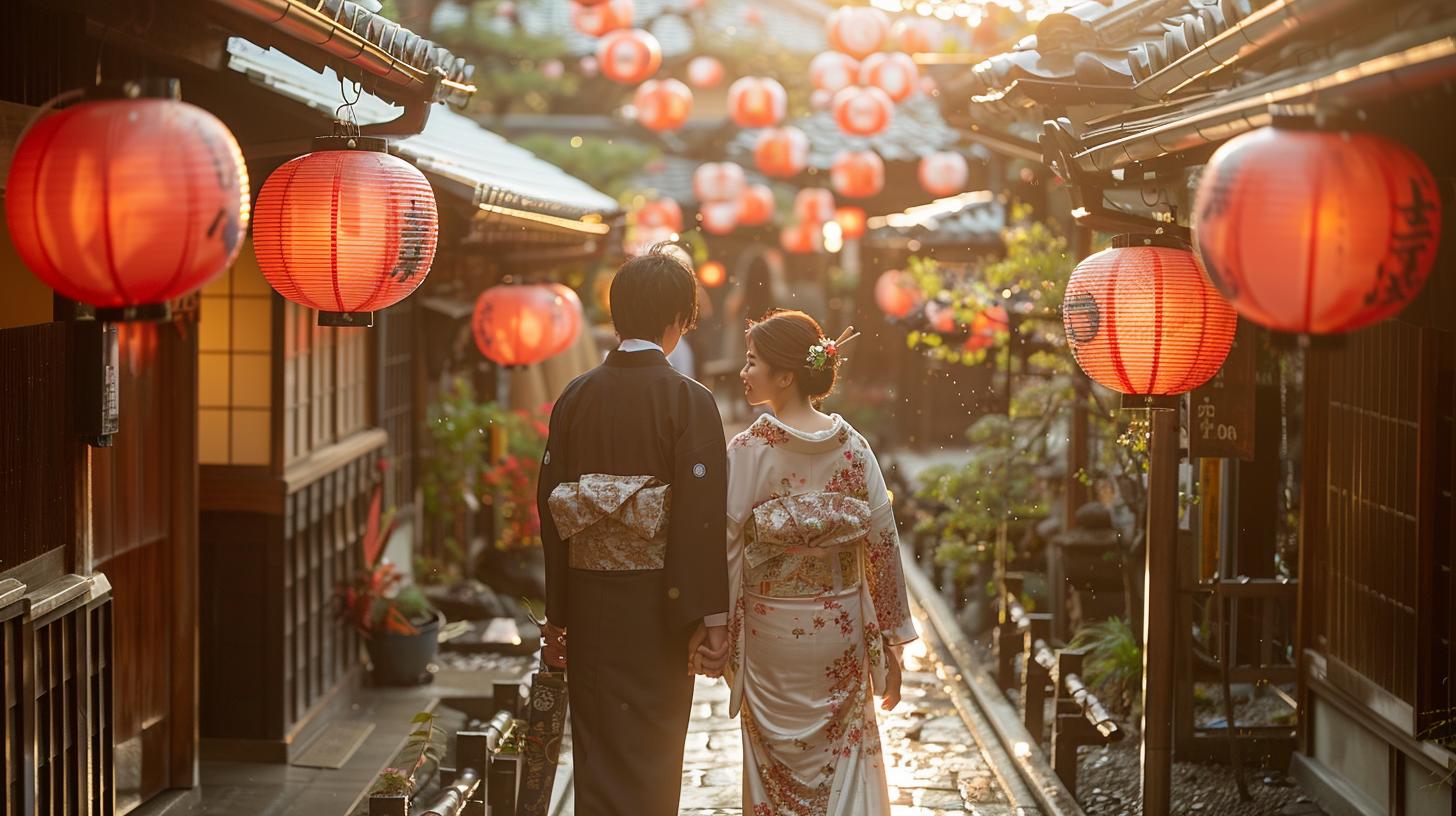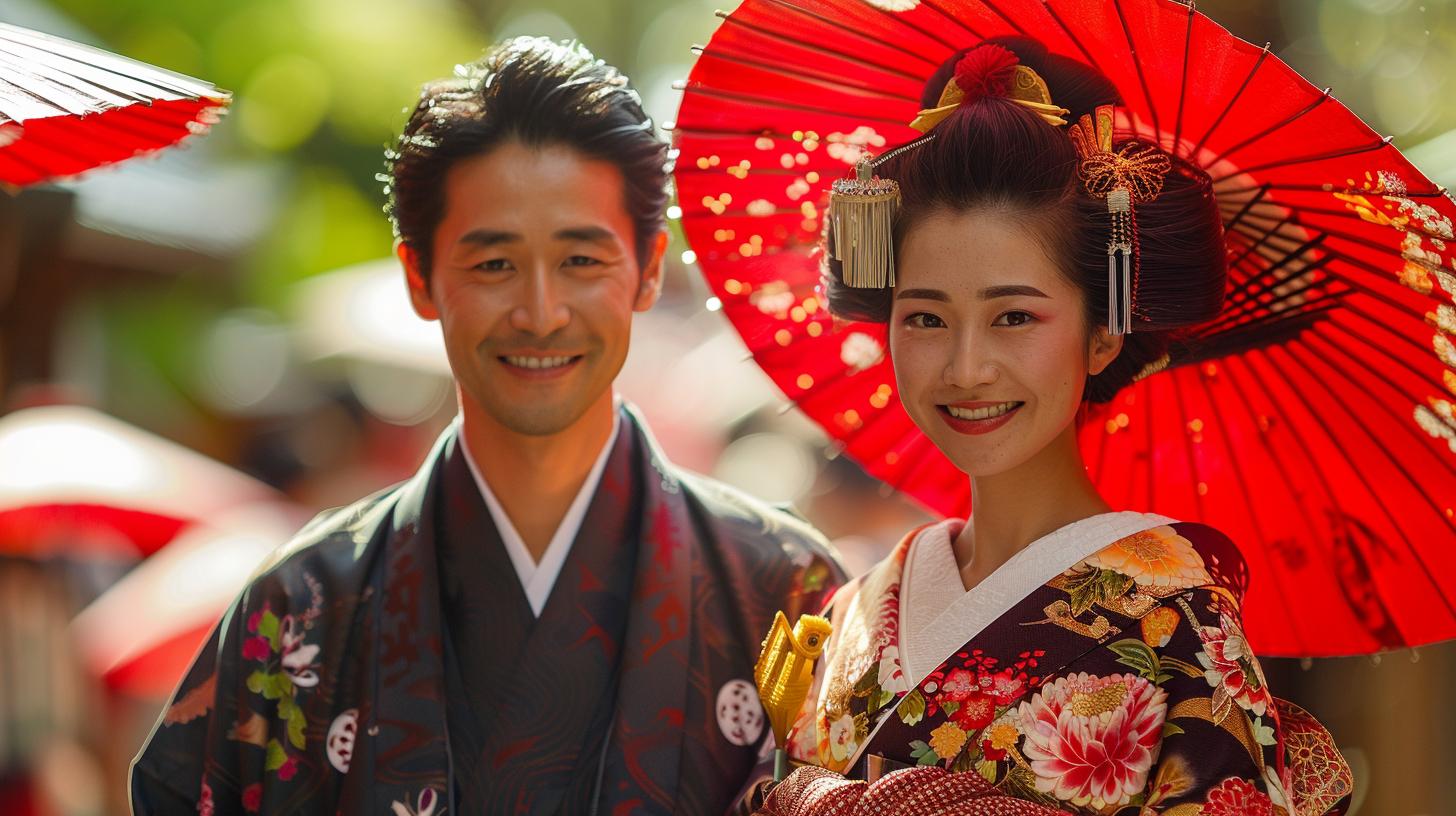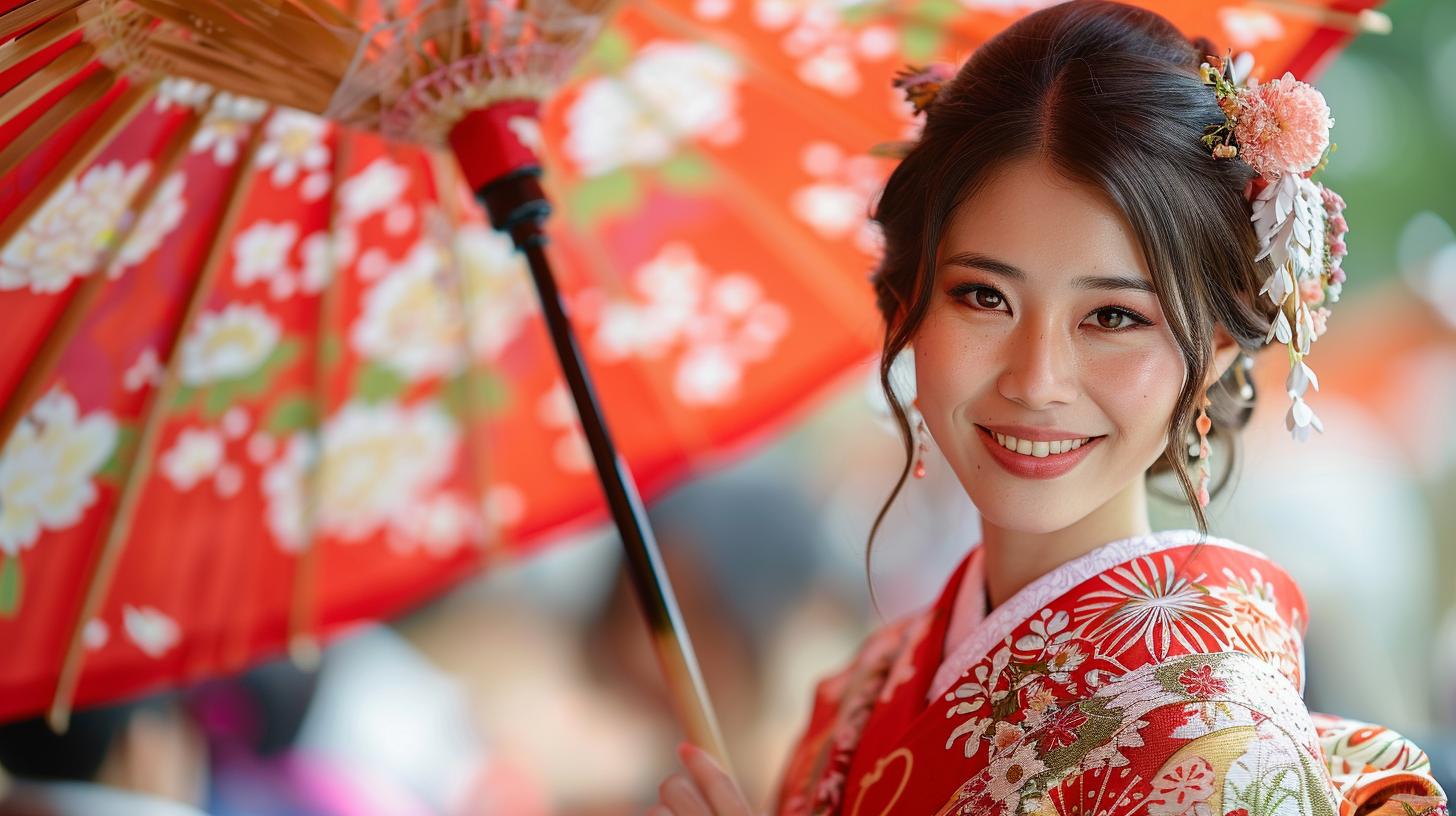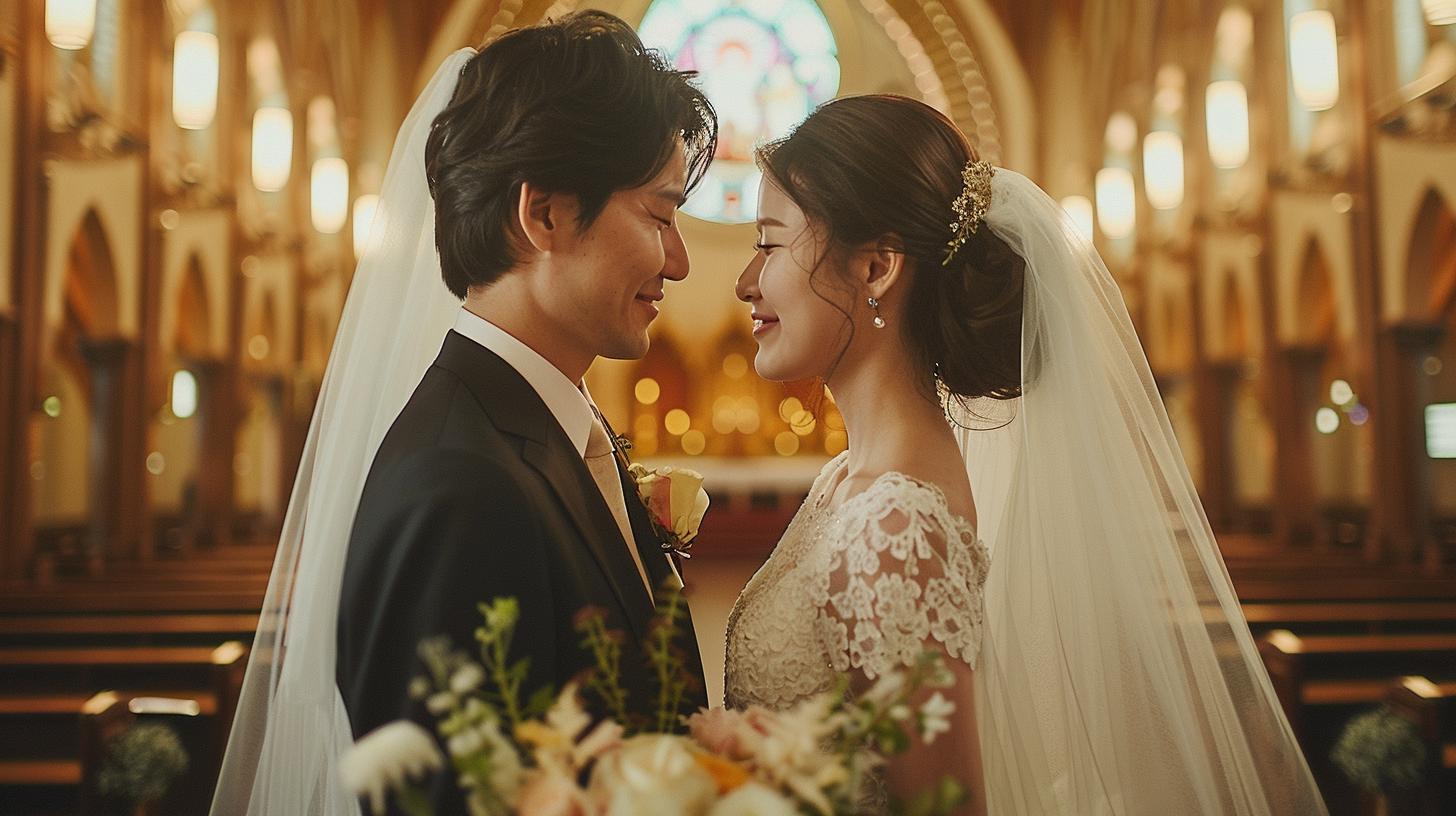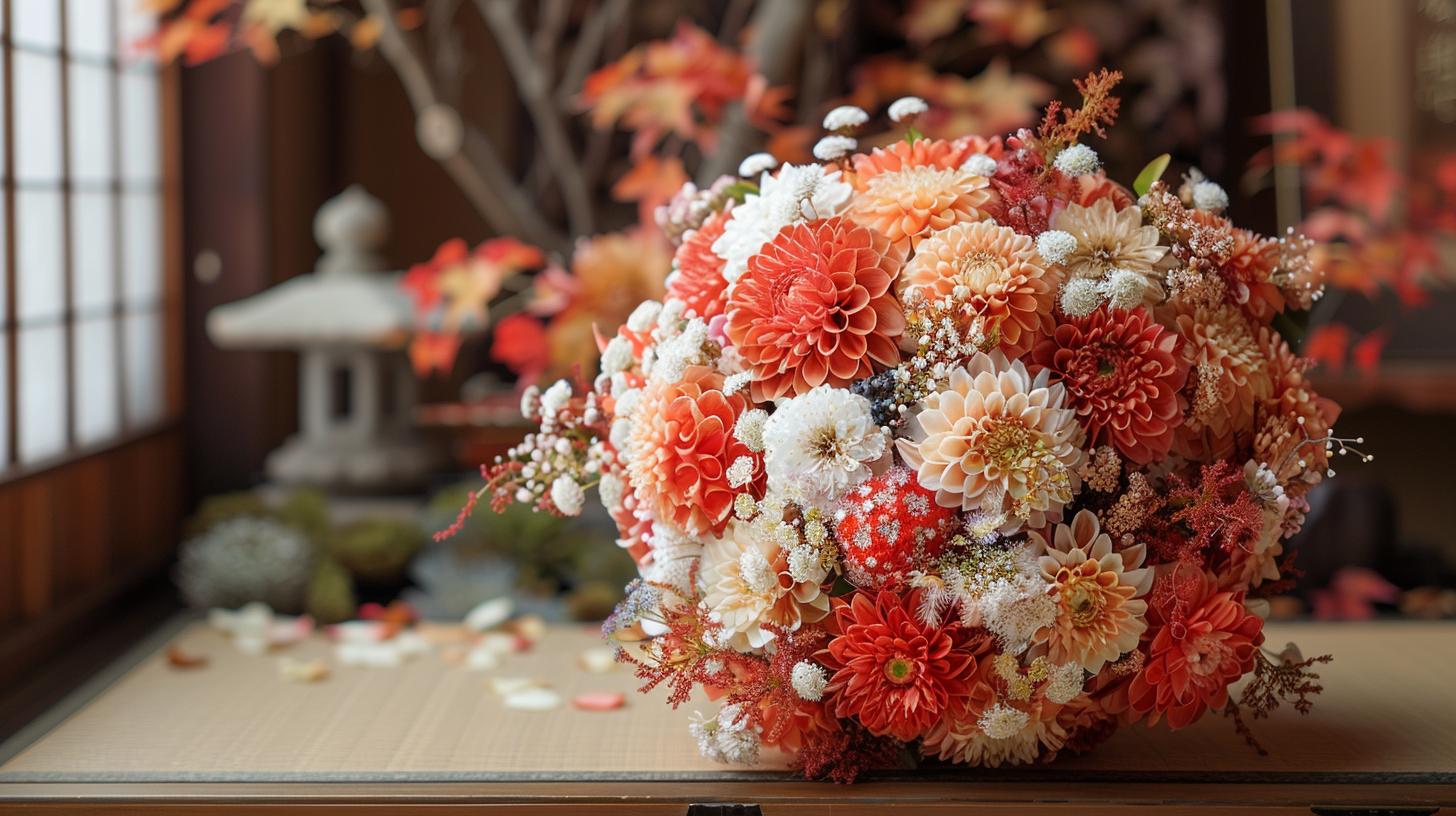Traditional Japanese Wedding Kimono: A Symbol of Elegance and Tradition
Traditional Japanese Wedding Kimono are an essential part of traditional Japanese wedding ceremonies. The kimono symbolizes elegance and tradition, with each style having its own unique history and significance.
These beautiful garments, including the kimono uchikake, which is a specific type of wedding kimono, play a pivotal role in the cultural fabric of Japanese celebrations.
The japanese kimono worn during the wedding ceremony is often adorned with exquisite designs that tell a story of the couple’s journey together.
The various styles of kimono women also contribute to the richness of this cultural attire. For instance, the shiromuku is traditionally worn by brides, embodying purity, while the iro-uchikake showcases vibrant colors and intricate patterns.
Many brides will wear a white kimono for their special day, further enhancing the traditional aesthetic.
From the pure white shiromuku to the colorful iro-uchikake, these bridal kimonos play a significant role in the wedding day attire.
The use of symbolic colors and high-quality materials adds to the cultural richness of these ceremonial garments. Accessories, such as the obi and haori himo, complete the look and enhance the overall elegance of the kimono.
The kimono obi, a crucial accessory, ties the outfit together, reflecting the artistry of the kimono artisans who craft these exquisite pieces.
The japanese wedding kimonos are not only beautiful but also signify the deep-rooted traditions of japanese women who have worn them for generations.
The traditional japanese wedding kimono is often a reflection of the bride’s family’s heritage and values. In fact, the kimono are made from exquisite fabrics that include gold green tones and vibrant hues, symbolizing prosperity and happiness.
The intricate details often feature cranes pine and flowers, representing good fortune and beauty.
For instance, there are many hiki furisode which are embroidered with intricate designs, showcasing the craftsmanship of the period and the significance behind each stitch.
You need to know that the hiki furisode has been popular with upper class, rich merchants and aristocrats during formal ceremonies. These styles are often complemented with lucky charms and accessories that carry personal meanings for the bride, adding layers of significance to the outfit.
Evolution of Traditional Japanese Wedding Kimono
The evolution of traditional Japanese wedding kimono encompasses a rich history that reflects the cultural significance and artistic craftsmanship of this iconic garment. From its historical origins to the changes over time, the influence of the Kyoto textile industry has played a pivotal role in shaping the intricate design and symbolic meaning of these bridal kimonos.
The talented kimono artisans continue to innovate while honoring traditional methods.
The edo period especially marked a time of refinement and innovation in kimono the art of textile making, introducing styles that are usually worn for the most formal ceremonies.
During the latter half of the muromachi period, the kimono which emerged became a symbol of status, with unique designs often incorporating elements like cranes pine and flowers symbolizing longevity and happiness.
The hakama men were also popular during this period, complementing the attire of grooms and marking an important aspect of wedding attire.
Historical Significance and Origins
The roots of traditional Japanese wedding kimono can be traced back to ancient traditions and customs that have been passed down through generations. These garments carry deep cultural significance, symbolizing purity, elegance, and the unique heritage of Japanese weddings.
The wedding kimono uchikake is often selected for its vibrant colors, making it a favorite among brides. The wedding kimono women wear is a celebration of their family’s legacy and personal style.
The shiromuku meaning is deeply rooted in the notion of purity, and the traditional shiromuku is often accompanied by a bridal veil, enhancing the bride’s grace. In the past, kimonos were originally worn by brides in a ceremonial context, making them an integral part of the wedding ceremony.
You need to know that the black version of the kimono, known as the black uchikake, also signifies different traditional values. The intricate designs and craftsmanship of these garments reflect the artistry that has been preserved through generations, celebrating the kimono mens styles that have also evolved.
The historical origins of these kimonos reveal a fascinating journey of artistry and tradition, where the edo period marked significant advancements in textile making and kimono design. Originally worn by the elite, the kimono evolved into various forms, with each japanese traditional wedding kimono having its own unique characteristics.
The variety includes long sleeved options that are perfect for formal occasions.
The influence of societal changes can be seen in the designs, especially with the introduction of vibrant colors and patterns that the black and white kimonos represent.
There are many hiki furisode which are rich in embroidery, showcasing the artistry of the time.
Changes Over Time
Over the centuries, traditional Japanese wedding kimono have undergone changes in style, design, and symbolism, reflecting shifting societal norms and aesthetic preferences. From subtle alterations to more dramatic transformations, the evolution of these kimonos showcases the dynamic nature of Japanese fashion and craftsmanship throughout history.
The edo komon and komon edo styles are prime examples of how intricate designs have adapted over time. During the edo period, many designs incorporated elements like cranes and pine, symbolizing longevity and prosperity.
The hair styling of brides has also evolved, with traditional styles blending with modern aesthetics, especially when wearing a kimono with contemporary accessories.
Influence of Kyoto Textile Industry
The Kyoto textile industry has long been renowned for its exquisite craftsmanship and expertise in creating traditional Japanese textiles, including the intricately woven and dyed fabrics used in wedding kimono. The skilled artisans of Kyoto have played a significant role in preserving and innovating the art of kimono-making, ensuring that each garment is a masterpiece of beauty and cultural heritage.
The regular price of these garments reflects the intricate work and high-quality materials involved, including the fukuro obi, which adds an elegant touch to the overall attire. Many brides choose a nagoya obi or a obi fukuro for their wedding day, enhancing the overall aesthetic of the kimono worn.
The artisans understand that the hair styling and accessories complete the look, making the bride’s appearance unforgettable. For this reason, selecting the right hair style is essential to complement the traditional attire, especially during significant occasions such as weddings.
Types of Traditional Japanese Bridal Kimono
Shiromuku Kimono: Symbol of Purity and Tradition
Many brides choose to wear tabi socks and other traditional accessories, completing their ensemble. The kimono mens styles also play an important role in these ceremonies, showcasing the unity between partners.
Meaning and Symbolism
The white color of the shiromuku kimono represents purity and the beginning of a new chapter in the bride’s life. It reflects the bride’s commitment to her partner and her desire for a successful and harmonious marriage.
The shiromuku wedding kimono is a classic choice for many japanese women on their wedding day, often paired with a fukuro obi and obiage obijime for a complete look. There are many hiki furisode which can also be used for this occasion, showcasing the rich tapestry of choices available to modern brides.
Iro-Uchikake Kimono: Vibrant Designs and Elegance
The iro-uchikake kimono is known for its vibrant designs and intricate embroidery, adding a touch of elegance to the bride’s wedding attire. This kimono is a stunning display of Japanese craftsmanship and artistry, often featuring designs that incorporate both cranes pine and floral motifs.
The uchikake wedding kimono is often adorned with striking colors that make the bride stand out during the wedding ceremony. It is not uncommon to see red uchikake or silk uchikake options, which bring a modern twist to this traditional garment.
The reason for selecting such vibrant attire lies in the cultural belief that it brings joy and prosperity to the couple.
For more insights into the various styles and meanings behind Japanese bridal kimonos, you can explore Japanese Wedding Theme Ideas.
Embroidery and Decorative Elements
The iro-uchikake kimono features elaborate embroidery and decorative elements, such as floral motifs, birds, and other traditional Japanese symbols. These intricate designs symbolize prosperity, happiness, and good fortune for the newlyweds.
The use of tabi socks and socks and other accessories complements the overall look, ensuring that every detail is attended to. The presence of embroidered cranes in the designs adds a layer of significance, as these motifs are often associated with longevity and good fortune in the context of Japanese weddings.
Additionally, the rich patterns, which are embroidered, enhance the visual appeal and cultural depth of the attire. The vibrant colors of red and black are also commonly featured, reflecting both beauty and tradition.
Ceremonial Attire for the Wedding Day
When it comes to the ceremonial attire for a traditional Japanese wedding, both the bride and groom carefully select their kimonos to reflect the solemnity and beauty of the occasion.
The choice of the japanese kimono is crucial, as it signifies the couple’s taste and their respect for tradition. Many couples opt for a vintage silk wedding theme, which beautifully showcases the elegance of the vintage Japanese kimono.
Among the popular choices, the white kimono stands out, often regarded as the most formal option for brides, symbolizing purity and simplicity. This choice has been popular with brides who wish to embody grace and elegance on their special day.
Bridal Kimono Selection Process
The process of selecting the bridal kimono is a meticulous one, with attention to detail and cultural significance. The bride chooses a kimono that complements her personal style while honoring the traditions and symbolism of the occasion.
Many brides opt for a vintage silk wedding kimono, as it encapsulates the elegance and intricate craftsmanship of the past. Among the various styles, the vintage Japanese kimono stands out for its unique designs and historical significance, often featuring exquisite komon edo komon patterns that highlight the rich heritage of samurai families.
In the realm of formal attire for weddings, the uchikake was originally the garment of choice for brides, and today, it has also been popular with upper class families. The uchikake was originally the formal attire for wives, showcasing the historical importance of this garment in Japanese culture.
Groom’s Attire: Tomesode Kimono and Its Significance
The groom’s attire for the wedding day typically consists of a tomesode kimono, characterized by its understated elegance and refined simplicity. This kimono reflects the groom’s role in the ceremony and his commitment to the union.
Often, the groom may also wear a nagoya obi hanhaba, crafted from vintage silk, which complements the overall aesthetic of traditional Japanese wedding attire. These nagoya obi hanhaba pieces are especially significant as they provide a beautiful contrast to the bride’s vintage silk wedding kimono.
Both merchants and aristocrats during the muromachi period favored these styles, which are still cherished today. The harmony between the bride’s attire and the groom’s ensemble creates a visually stunning representation of love and commitment.
Changing Kimono for Different Parts of the Ceremony
Each kimono change signifies a transition in the proceedings and underscores the importance of traditional attire in Japanese weddings. The bride might start with a vintage Japanese kimono adorned with embroidered cranes, showcasing the beauty of the edo period, before transitioning into an uchikake vintage piece that adds layers of grandeur.
This practice not only highlights the intricacies of the vintage silk but also emphasizes the cultural richness of the ceremony. The uchikake was originally the most formal attire for wives, and its layered design symbolizes the support and love from family, particularly in rites that honor both the couple and their parents.
Symbolism of Colors and Materials
When it comes to Traditional Japanese Wedding Kimono, the colors and materials used hold significant symbolism and importance. Let’s explore the meaning behind the different colors in a kimono, as well as the significance of utilizing high-quality silk and other materials in the creation of these beautiful garments.
The vintage silk used in these kimonos often features intricate patterns that reflect the heritage of samurai families, tying their legacy to the modern celebration of love. Colors such as red and black are frequently used, symbolizing both power and formality, which are essential in traditional ceremonies.
The choice of colors and patterns is not just aesthetic; it is deeply rooted in cultural traditions and beliefs.
Meaning Behind Different Colors in Kimono
- White: Symbolizes purity and innocence
- Red: Signifies power, vitality, and celebration
- Black: Represents formality and a sense of mystery
- Blue: Symbolic of calmness and stability
Importance of Silk and Other Materials
When it comes to crafting Traditional Japanese Wedding Kimono, the choice of materials is crucial.
Silk is the most common fabric used due to its luxurious feel and ability to hold intricate designs. The vintage silk wedding kimonos are especially treasured for their unique textures and rich history.
However, other materials like cotton, polyester, and rayon are also utilized to offer more affordable options. The rich variety of vintage silk available today allows brides to choose from a stunning selection of vintage Japanese kimono styles that capture the essence of the edo period.
Furisode hiki furisode has been popular with upper class families for its vibrant colors and elaborate designs, making it a favorite choice for festive occasions, particularly during the fall season.
Quality and Craftsmanship
The quality of a kimono is often determined by the craftsmanship involved in its creation.
High-quality kimonos will feature hand-painted designs on silk fabric, showcasing meticulous attention to detail. The absence of visible seams and the use of top-grade materials reflect the skill and dedication of the artisans behind these exquisite garments.
The use of komon edo komon patterns often showcases the rich cultural tapestry of traditional Japanese attire, making each piece not just a garment but a work of art that tells a story.
The craftsmanship involved in creating these kimonos is what sets them apart, especially those that have been popular with rich merchants and aristocrats during the muromachi period. This reverence for quality and artistry remains a hallmark of traditional Japanese clothing.
Cost and Accessibility of Traditional Japanese Wedding Kimono
When it comes to the cost and accessibility of traditional Japanese wedding kimonos, there is a wide range of prices to consider. Factors such as materials used, craftsmanship, and custom designs can significantly affect the final cost of these exquisite garments.
Vintage silk kimonos, especially those with intricate embroidered cranes, can be particularly valuable due to their historical significance. The investment in a vintage silk wedding kimono is often seen as a reflection of the couple’s commitment to honoring their heritage.
Additionally, furisode has been popular among brides for its vibrant hues and dynamic patterns, reinforcing its status as an iconic choice for wedding celebrations.
Range of Prices and Factors Affecting Cost
- High-quality silk kimonos with intricate hand-painted designs can cost upwards of $800 USD, reflecting the time and skill involved in their creation.
- Kimonos made with alternative materials like polyester or rayon can offer more affordable options, ranging from $40 to $200 USD.
- The level of craftsmanship, including embroidery, dyeing techniques, and the absence of visible seams, can also impact the price of a traditional Japanese wedding kimono.
Rental Options and Considerations
For those seeking a traditional Japanese wedding kimono for a one-time event, rental options are available to provide a more budget-friendly alternative.
Renting a kimono can cost significantly less than purchasing one outright, making it a practical choice for those who may not wear the garment again. Many rental services offer an array of vintage silk wedding kimonos, allowing couples to experience the beauty and cultural significance without a long-term commitment.
Whether for the ceremony or the reception, each piece of attire holds a story, making the choice of kimono a crucial aspect of the wedding day, especially when considering the rich history behind styles like the hiki furisode, which has been popular with aristocrats during the muromachi period.
- Many bridal shops and kimono rental services offer a variety of styles and sizes to suit different preferences and body types, including selections from the vintage silk collection.
- Rental packages often include not only the kimono itself but also accessories such as obi belts, like nagoya obi hanhaba, footwear, and hair ornaments, providing a complete ensemble for the wedding day.
- It is important to consider the rental terms and conditions, including cleaning fees, return policies, and any additional charges for damages or alterations to the kimono.
.
.

